A revival of the Cold War era?
By the end of the Cold War, regional claims in the Arctic Circle had started to fall apart. First of all, the Western World did not have to compete anymore with the Soviet Union over military presence in geostrategic locations all over the world including the Far North. Another important parameter was the cold weather that was making vast areas of ice covering the North Pole difficult to reach, which had put off potential investment plans.
This period of idleness and the absence of military activity in the Arctic was yet to be interrupted by the latest global warmth. With the Arctic ice melting at a much more accelerating pace compared to the rest of the world, a previously inaccessible region is now becoming easier to reach and explore. According to NASA, the Arctic sea ice is dropping by nearly 13% per decade, reaching its lowest point in 2012.
As expected, more countries have started to reconsider their national strategy in the Far North; aiming to exert control over the Arctic natural resources including hydrocarbon reserves, fish and minerals.
For some peers, the future power distribution in the North Pole shall reflect that of the Cold War era. It is true that regional dispute claims have already started over the control of unchartered territory. Among them, Russia, China and the United States are competing over the dominance in the Arctic area, but each with different objectives and visions; for Russia, the Arctic region is of paramount importance for its national interests; for China, it’s the recognition of economic benefits hiding on the Arctic seabed; for the United States, this neglected for several decades region has started to grab the national attention. Therefore, it is yet to be seen how the future Arctic power distribution will be formed in the post-Cold-War era.
Why Arctic Circle matters
Based on the above analysis, it is obvious that the Arctic Circle has started to become a hotspot for economic and military competition. Amid an unstable economic environment, the Arctic has a huge economic potential for shipping transportation and exploitation of its natural resources.
Although remarkable steps have been taken within the Arctic Council1 to address climate change concerns and protect the Arctic environment, in geostrategic level, a rising aggravation – among the three powerful countries (US, Russia and China) and other regional players seeking to play an active role in the decision making – becomes a new reality. In order to better understand why the Arctic Circle matters for world politics, it is important to take a look at the motives of the regional powers.
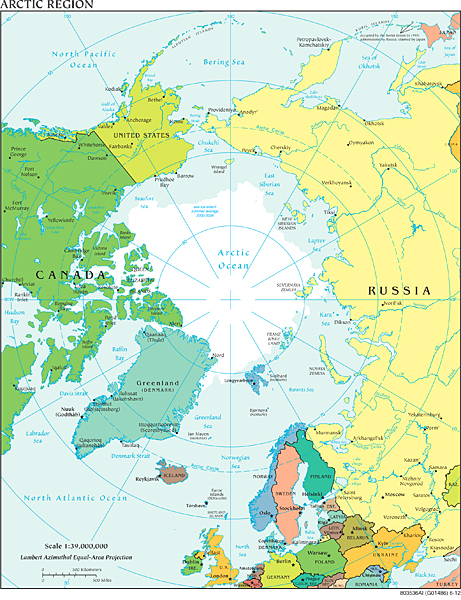
Photo: Central Intelligence Agency, Political Arctic Region. Source: (CIA) | (CC0 1.0)
- Russia
Starting from Russia, this country has considerable sway in the Arctic Circle and therefore holds vital interests in the Arctic region. With the Arctic territory covering one-fifth of Russia, natural boundaries surrounding the country for centuries and protecting it from external interference, are now collapsing with the melting of the ice. As a corollary, Russian military presence is expected to increase around its borders, owing to the proximity of neighbour states less favourably disposed towards Russia.
Of course, the recent revival of the Russian economy has encouraged domestic investment in military bases and equipment on the quest for hydrocarbons and control over the Northern Sea Route (NSR). A declaration of the above statement became evident in 2007, when Russia planted a flag in the North Pole. “A strategic move”, as described in the National Geographic article, “made with drama in mind”… possibly to provoke the United States, one might add (Shea, 2019).
Following Crimea’s annexation in 2014, the adoption of economic sanctions from the West has hampered further cooperation in the Arctic neighbourhood. Searching for an alternative route to boost the domestic economy, Russia turned its attention to the Arctic. From energy projects to opening the Northern Sear Route for trade purposes have begun to catch the US and Europe’s attention. Of course, Russia’s advanced Arctic equipment makes even harder for other Arctic countries to compete with Kremlin. However, a balance of power should be perceived as a positive development contributing to a healthy stabilisation in the North Pole.
- United States
Recognising the huge economic potential in the Arctic, the United States has started to shift gradually its geostrategic interests in the Arctic region. With Trump questioning the alarming warnings on climate change, the Arctic is now seen as a pool of hydrocarbon reserves and a strategic passage connecting the East with the West. Indeed, the NSR is really crucial for the US Naval forces on their quest against the Chinese counterparts, whose fight for dominance in the South China Sea is part of the Chinese Silk Road initiative that will be discussed below.
Apart from the economic and environmental issues prevailing in the Far North, the reinstatement of the US position in the Arctic is a direct response to Russia’s recent militarisation plans in the Arctic2 – starting with the renovation of facilities in key areas such as Iceland and the replacement of old military equipment including two ageing vessels.
It is therefore clear that Trump’s administration places great emphasis in the Arctic security and is willing to take further steps to level out the playing field with Russia and China. Last year, Pompeo’s speech during the Arctic Council’s Ministerial meeting in Finland revealed the US dispute over the Russian claims in the Northern Sea Route, as well as Canada’s Sovereignty over the Northwest Passage (Lanteigne, 2019).
In addition, the US Congress released on June 9 a new Memorandum3 – highlighting the importance of acquiring polar security icebreakers. Despite that icebreakers are not the sole passage to granting US dominance in the Arctic, this move is rather symbolic, revealing the US intentions to overstep its game in the Far North.
- China
Although not considered an actual Arctic state, China sees itself as a ‘’Near Arctic’’ player. As the 2018 Arctic White Paper reveals, China aims to participate actively in the future Arctic negotiations, as part of its wider vision to become a global balancing power contributing to the regional and global cooperation.
Towards this direction, Beijing managed to earn successfully the status of permanent observer in the Arctic Council in 2013 and secure a position in future negotiations. This step is quite an achievement, given the strict admission requirements4 of the Council.
Undoubtedly, China has developed a strong presence in the wider Arctic region by securing direct investment plans in Finland and Norway. For sure, China’s commercial interests are closely intertwined with the South China Sea and the Arctic Ocean, that China sees both as two connecting pieces to the Silk Road Initiative5, known also as the ‘’Polar Silk Road’’.
The above geo-strategic aspirations topped with the current Chinese plans to expand economic activities in Greenland and invest in Arctic military technology exacerbate even further the US reaction, which in turn adds more tension to the existing regional dispute.
- Other regional players
With more Asian and European countries6 joining the Arctic debate, seeking to seize political and economic benefits, the Arctic is shifting from a periphery of regional importance to a global security issue. This is no exception even to moderate states on the Arctic affairs, such as Canada7. Although the latter is an ardent advocate of sustainable economic development in the Arctic, this does not infer that Canada has no territorial claims in the region. As a matter of fact, Canada has taken the first step to ‘’obtain UN recognition of its continental self-limits in the Arctic Ocean’’ in 2019 (Government of Canada, 2019).
Evidently, multiple regional disputes have recently emerged over the maritime boundaries in the area. Two recent disputes – in the Barents Sea between Russia and Norway and the Lomonosov Ridge dispute between Russia, Canada and Denmark – show how easily an interstate disagreement can lead to a regional dispute, by dragging existing coalitions, such as NATO or the EU, into a new collision.
In the last two examples, it is apparent that the European Union could easily intervene, leading to a potential regional dispute. First of all, three out of the eight members of the Arctic Council – Denmark, Sweden and Finland – are also members of the EU. However, the EU does not have visibility on the discussions of the forum8, which complicates matters even further. By lacking a seat on the negotiating table between the inflicted parties, the EU cannot act as a mediator to avert a potential ciris. At the same time, the EU recognises the Arctic as a key driver for the ocean and climate system. Staying committed to environmental protection, the EU seeks to work closely with the Arctic States, local governments and other stakeholders in the area to address these challenges and develop an EU Arctic policy.
In the meantime, NATO has started to launch naval exercises in the area. As a response to the recent Russian claims9, NATO has also executed its largest exercise in the Trident Juncture in 2019. All these signify the readiness of the North Atlantic alliance to confront its counterparts in the Arctic sea. In the absence of demilitarisation agreement similar to Antarctica10, a regional competition between Russia and the North Atlantic alliance can easily escalate the regional tension, which would bring back memories from the Cold War era.
Building a future that policymakers will need to consider or reconsider
Looking into the future, what policymakers and international organisations should really be concerned about is the environmental impact caused by the melting of the Arctic ice due to climate change. Although oil and gas corporations constantly seek new areas to drill, would such an investment be a wise move? This contradicts the current initiatives to transition over a low carbon economy.
Subsiding oil and gas production might prove beneficial for the short-term, but on the long-run, it will only slow-down or intercept with the deployment of renewable technology, which is crucial for cutting down the cost of large-scale low carbon projects and turning them into more cost-effective investments for the future. By locking in investments in such projects, it is quite obvious that the public attention will move away from the real benefits of a low carbon economy and its future.
Another important factor that policymakers should keep in mind is that the oil spills can be detrimental to the Arctic ecosystem, as clearly shown in the recent oil spillage in the Russian Arctic, which is discussed thoroughly in this recent article. Due to low temperatures and limited sunlight adding to the remoteness of the Arctic, such an accident can take several decades to clean up an oil spillage.
On the other hand, the control of the Trans-arctic route will play a more strategic role in the coming period. By opting for the Arctic routes, ships and tankers save vital shipping time and render travel cost shorter. On the other end, the use of these routes will require advanced equipment such as modern icebreakers that will allow them to travel across the Arctic Ocean outside the summer months. Of course, such technology is currently available only in Russia, so other Arctic countries will need to reconsider their future options – should they wish to limit Russia’s comparative advantage on the northern shipping routes.
Again, controlled shipping across the North Pole will need to be in harmony with the protection and respect of the Arctic wildlife and ecosystem. ‘’Increased oil and gas exploration and tourism in the Arctic increase the risk of pollution in the region’’, warns a recent paper of the Congress (Congress, 2020). Therefore, endangering animal species that find shelter in the Arctic could have a huge impact on the food chain and the wildlife not only for the region but on a global level. Similarly to Antarctica, the North Pole is the corner of our planet and world heritage to pass on future generations. Therefore, it is a duty of all governments to protect at all costs from inconsiderable and non-sustainable economic activity.
Photo: 176th Wing Alaska Air National Guard, 60315-Z-MW427-956. The sun rises over Ice Camp Sargo on the Arctic Circle, March 15, during Ice Exercise 2016. (2016). Source: (flickr.com) | (CC BY 2.0)
Footnotes
[1] The Arctic Council:
The Arctic Council consisting of 8 Arctic countries – Russia, Iceland, Norway, Finland, Sweden, Denmark, US and Canada. The decision to form a regional organisation in 1996 was a huge step to establish a balance in the Far North and promote cooperation. Not only the Council has helped the countries to resolve regional disputes through negotiation, but also to protect their exclusive interests in the area from any outsiders.
Despite the environmental and economic cooperation, the Council does not extend its activities in security matters that still seem to be dominant in the area. As a matter of fact, the meltdown of the ice will probably exacerbate existing arguments rather than unite member states against climate change. Also, the differentiation of existing views over the membership status – by extending or restricting this right to non-Arctic countries – seems to be another weak spot for the forum’s effectiveness.
[2] A direct response to Russia’s recent militarisation plans in the Arctic:
For Russia, the Arctic region has become an area of major military movement. This includes the recent reopening of Cold-War military installations along with large-scale military exercises and close monitoring of foreign vessels and aircraft in the area through the use of trans-Arctic radar equipment.
[3] A Memorandum:
The Memorandum on Safeguarding US National Interests in the Arctic and Antarctic Region provides that:
- ‘’at least three heavy polar-class security cutters (PSC) that are appropriately outfitted to meet the objectives of this memorandum’’ (The White House, 2020);
- ‘’at least two optimal the United States basing locations and at least two international basing locations’’ (The White House, 2020);
[4] Strict admission requirements:
As a prerequisite for joining the Council, candidate observing states are obliged to: a) recognise the exclusive sovereign rights of the Arctic members in the North Pole, b) to accept the provisions of the UN Convention for the Law of the Sea (UNCLOS).
[5] China sees both as two connecting pieces to the Silk Road Initiative:
A great example is the Yamal LNG project, ‘of which the Silk Road Fund holds 9,9% shares, is one of the specific activities’’, as highlighted on a World Economic Forum’s analysis (World Economic Forum, 2018).
[6] More Asian and European countries:
Japan, South Korea, Germany, France, Italy and the UK.
[7] Canada:
Canada is another Arctic country with vital interests in the area, but the main focus remains on sustainable economic development. With 40% of the Canadian territory located in the Arctic, the country envisions itself as a leader in Arctic science and research and welcomes the economic potential in the area, but in a responsible way and with respect to the indigenous people living in the Arctic and the environment.
[8] EU does not have visibility on the discussions of the forum:
Despite the EU has already applied for the observer status in the Arctic Council, its application has not been accepted yet.
[9] Recent Russian claims:
Following the 2014 Russian – Ukrainian conflict, Crimea’s annexation from Russia has risen the tension between Russian and the West.
[10] Antarctica:
Contrary to the Arctic Circle, Antarctica is protected under the Antarctic Treaty, a legally binding international agreement that prohibits any national claims. Therefore, the South pole continent consists of a grey area for the international community, allowing only activities for peace and science purposes.
Bibliography
Arctic Centre University of Lapland, Arctic International Cooperation, Arctic Region, Available at: https://www.arcticcentre.org/EN/arcticregion/international# (Accessed 23rd June 2020)
Astrasheuskaya N. and Foy H. (2019) Polar powers: Russia’s bid for supremacy in the Arctic Ocean, The Financial Times, 28th April, Available at: https://www.ft.com/content/2fa82760-5c4a-11e9-939a-341f5ada9d40 (Accessed 22nd June 2020)
Brzozowski A. (2020) Global Europe Brief: Arctic Special, Euractiv, 30th January, Available at: https://www.euractiv.com/section/global-europe/news/global-europe-brief-arctic-special/ (Accessed 23rd January)
Cockburn H. (2020) Climate crisis: Arctic temperatures ‘break records’, as ice melting season starts early, The Independent, 18th May, Available at: https://www.independent.co.uk/environment/arctic-sea-ice-temperature-spring-record-high-melt-climate-change-environment-a9519931.html (Accessed 23rd June 2020)
Congress (2020) Changes in the Arctic: Background and Issues for Congress, Congressional Research Service, 22nd May, Available at: https://fas.org/sgp/crs/misc/R41153.pdf (Accessed 23rd May 2020)
Conley A. H. and Shafron M. (2020) Is the United States Having an ‘Arctic Moment’ on Icebreaker Acquisition? Center for Strategic & International Studies, 12th June, Available at: https://www.csis.org/analysis/united-states-having-arctic-moment-icebreaker-acquisition (Accessed 21st June 2020)
European Commission (2019) Arctic. The Changing Arctic environment, Environment, Available at: https://ec.europa.eu/environment/international_issues/arctic_en.htm (Accessed 22nd June 2020)
Greenpeace, The Arctic & Global Warming, Available at: https://www.greenpeace.org/usa/arctic/issues/global-warming/ (Accessed 23rd June 2020)
Government of Canada (2019) Canada and the circumpolar Arctic, Available at: https://www.international.gc.ca/world-monde/international_relations-relations_internationales/arctic-arctique/index.aspx?lang=eng (Accessed 23rd June 2020)
Lanteigne M. (2019) The changing shape of Arctic security, NATO Review, 28th June, Available at: https://www.nato.int/docu/review/articles/2019/06/28/the-changing-shape-of-arctic-security/index.html (Accessed 17th June 2020)
NASA (2020) Arctic Sea Ice Minimum, Global Climate Change, Vital Signs of the Planet, Available at: https://climate.nasa.gov/vital-signs/arctic-sea-ice/ (Accessed 23rd June 2020)
NASA (2020) Global Temperature, Global Climate Change, Vital Signs of the Planet, Available at: https://climate.nasa.gov/vital-signs/global-temperature/ (Accessed 23rd June 2020)
Roston E. and Migliozzi (2017) How a Melting Arctic Changes Everything, Part II: The Political Arctic, Bloomberg, 16th May, Available at: https://www.bloomberg.com/graphics/2017-arctic/the-political-arctic/ (Accessed 21st June 2020)
Shea N. (2019) Scenes from the new Cold War unfolding at the top of the world, National Geographic, 8th May, Available at: https://www.nationalgeographic.com/environment/2018/10/new-cold-war-brews-as-arctic-ice-melts/ (Accessed 17th June 2020)
The White House. National Security & Defense (2020) Presidential Memoranda: Memorandum on Safeguarding U.S. National Interests in the Arctic and Antarctic Regions, Donald J. Trump, Available at: https://www.whitehouse.gov/presidential-actions/memorandum-safeguarding-u-s-national-interests-arctic-antarctic-regions/ (Accessed 21st June 2020)
US Department of State, Office of Ocean and Polar Affairs, Arctic Region, Available at: https://www.state.gov/key-topics-office-of-ocean-and-polar-affairs/arctic/ (Accessed 22 June 2020)
Wood J. (2019) 4 crazy things that are happening in the Arctic right now, World Economic Forum, 19th July, Available at: https://www.weforum.org/agenda/2019/07/4-crazy-things-that-are-happening-in-the-arctic-right-now/ (Accessed 23rd June 2020)
World Economic Forum (2018) China aims to play a major role in Arctic affairs. Here are its 5 key policy goals, in collaboration with the China Institute of International Studies, 27th July, Available at: https://www.weforum.org/agenda/2018/07/china-aims-to-play-a-major-role-in-arctic-affairs-here-are-its-5-key-policy-goals/ (Accessed 21st June 2020)
WWF, Arctic Oil and Gas, WWF Arctic Programme, Available at: https://arcticwwf.org/work/oil-and-gas/ (Accessed 23rd June 2020)
WWF, Arctic Shipping, WWF Arctic Programme, Available at: https://arcticwwf.org/work/shipping/ (Accessed 23rd June 2020)

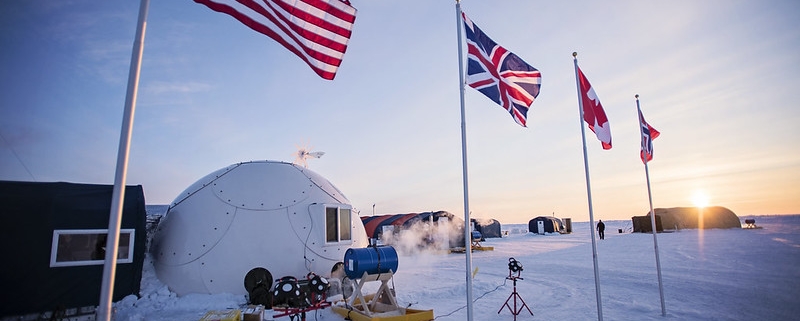 176th Wing Alaska Air National Guard's photostream
176th Wing Alaska Air National Guard's photostream 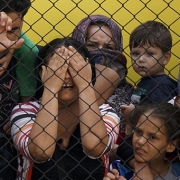
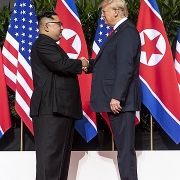
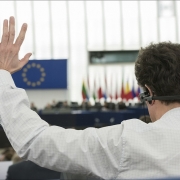
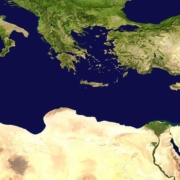
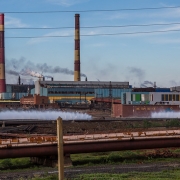
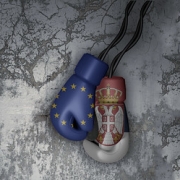



Leave a Reply
Want to join the discussion?Feel free to contribute!